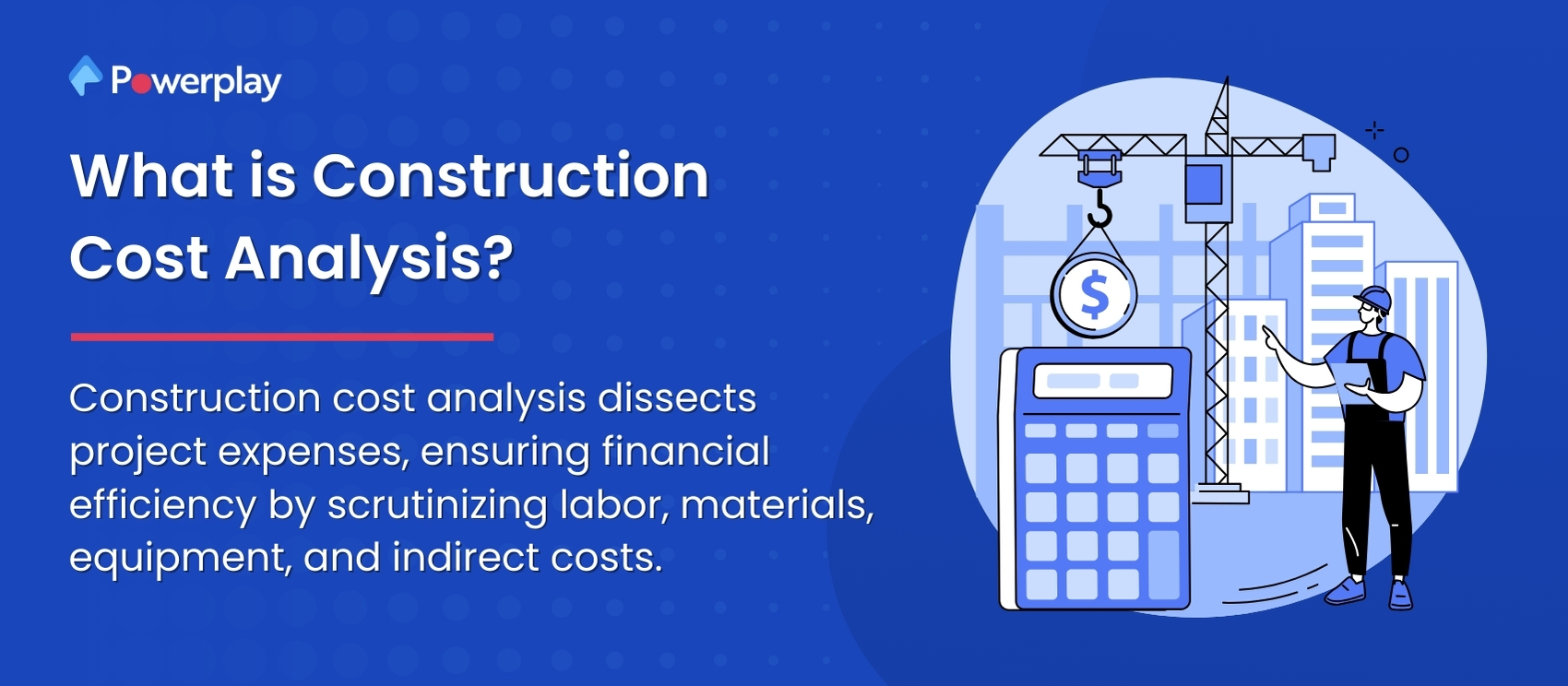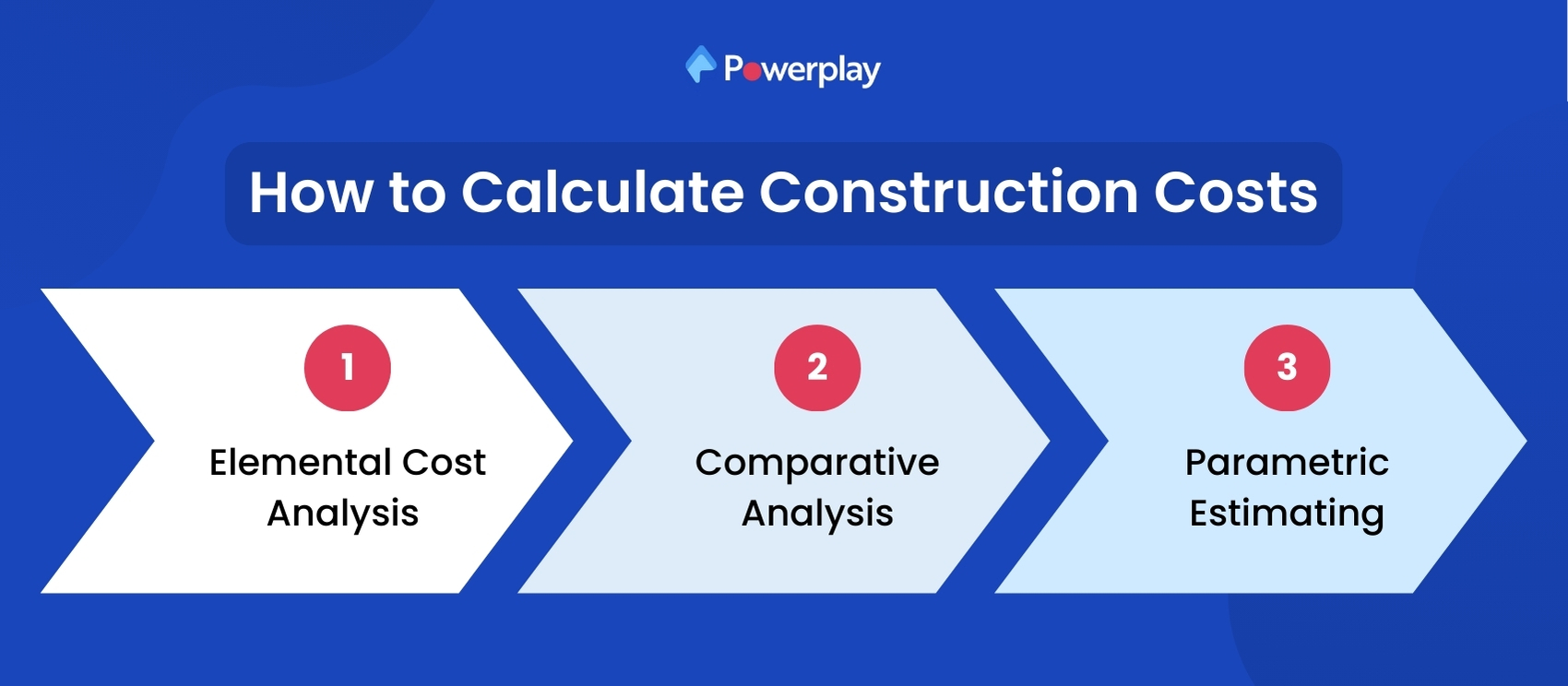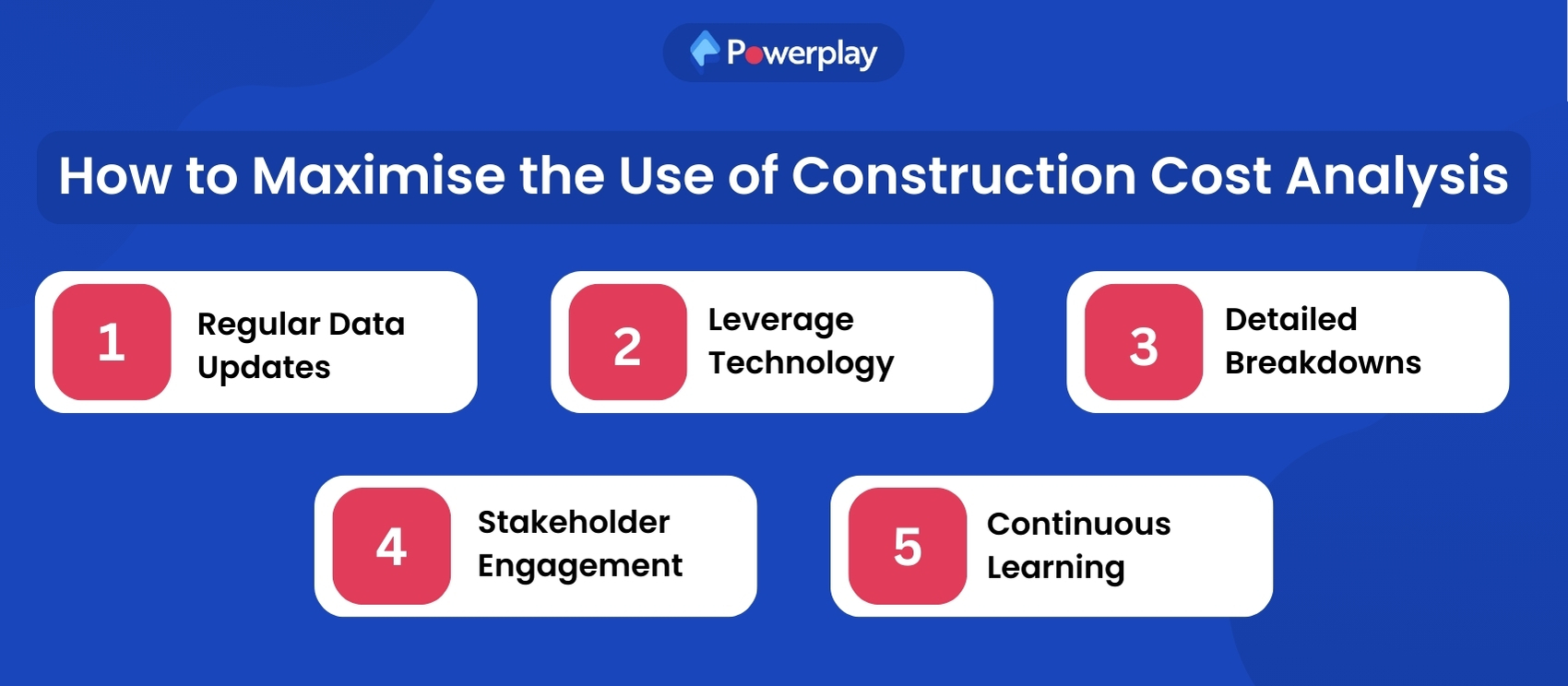Construction Cost Analysis: A Comprehensive Guide
-
Sapna
- May 31, 2024

Whether you’re a seasoned project manager, a financial planner, or someone just entering the construction realm, understanding how to analyse and manage costs effectively is crucial for the success of any project.

This blog will explore the fundamentals of construction cost analysis, its importance, methods, and best practices. By mastering these principles, you can ensure your project completion is on time, within budget, and to the highest quality standards.
Table of Contents
What is Construction Cost Analysis?

Construction cost analysis evaluates and breaks down the total costs of a construction project to ensure financial efficiency and accountability. This analysis includes the detailed examination of all expenses related to the project, such as labour, materials, equipment, and subcontractor fees, as well as indirect costs like administrative expenses and overhead.
The goal of construction cost analysis is to forecast the project’s financial requirements, manage the budget effectively, and make informed decisions that can leads to cost savings without compromising the quality or scope of the project. It is a vital tool for project managers to control spending, optimise resource allocation and project efficiency, and ensure the cost engineering of the project remains within the financial boundaries set by stakeholders.
Benefits of Construction Cost Analysis

Benefits of Conducting Cost Analysis in Construction Projects
Reduces Financial Risks
Conducting a thorough project cost analysis helps manage and control construction expenses efficiently. This strategic oversight enables precise monitoring of labour and material costs incurred, ensuring financial stability throughout the project lifecycle.
Facilitates Informed Decision-Making
Cost analysis empowers project managers to make data-driven decisions. By using cost drivers and understanding the financial dynamics of various projects, managers can prioritise resource allocation and expenditures more effectively, ensuring optimal project outcomes.
Identifies Cost Overruns in Early
Cost overruns are a common challenge in construction, but proactive cost analysis can mitigate these risks. By identifying potential overruns early, managers can negotiate better prices, optimise resource utilisation and unit costs, and enhance productivity, safeguarding the project budget against unforeseen expenses.
Increases Stakeholder Confidence
Detailed and accurate cost estimation methods and analyses of comparable project data can demonstrate potential cost savings and project efficiencies, garnering support from key stakeholders. This support is crucial for securing future projects and maintaining a competitive edge in the industry. Effective cost management through analysis not only saves money but also enhances the overall sustainability of the project.
The Importance of a Construction Cost Analysis
A construction cost analysis is essential for effectively managing the financial aspects of building projects. It involves estimating all costs associated with a project, including materials, labour, equipment, and overheads, to make sure that the budget aligns with the financial goals. This analysis aids in identifying potential cost overruns early, allowing adjustments before they escalate. It also helps stakeholders to make informed decisions, optimise resource allocation, and enhance profitability. Accurate cost analysis is crucial for winning bids, maintaining competitiveness, and ensuring project success. It forms the basis for transparent financial management and strategic planning in the construction industry.
How to Conduct Construction Cost Analysis

Steps to Perform a Construction Cost Analysis
Collect All Project Information
Start by gathering all the documents and details related to the project. This includes construction plans, contracts, invoices, and any other paperwork. Understanding the project’s scope and schedule helps you get a clear picture of all the costs involved.
Organise Costs into Categories
Break down all the costs into categories like labour, materials, equipment, subcontractors, permits, other overhead costs, and any unexpected expenses. Organising costs this way makes handling and analysing where the money is going easier.
Set Up a Cost Baseline
Create an initial budget or estimate at the project’s start. This baseline will help you track how well you stick to the budget as the project progresses.
Keep Track of Spending
Record all expenses regularly as the project progresses. This includes everything from the number of labour hours your workers are logging to the amount of material used. Ensure this information is accurate and updated often, especially if your project falls behind schedule.
Compare Budgeted Costs to Actual Expenses
Look at the differences between what you planned and what you spent. Understanding why these differences exist, whether due to unexpected changes or market price increases, can help you manage costs better.
Forecast Future Costs
Use past cost data and current trends to predict future expenses. Consider economic changes, material costs, or potential delays that might affect the total project cost. Accurate forecasting helps you prepare and make smart decisions.
Evaluate Cost Efficiency
Measure how effectively the project uses its budget using specific metrics like the cost performance index (CPI) and earned value. These figures show whether you’re over or under budget and by how much.
Look for Ways to Save
Always look for opportunities to cut costs. This might mean negotiating deals with suppliers, finding more efficient work methods, or eliminating unnecessary expenses.
Report Your Findings
Share your analysis with all stakeholders clearly and straightforwardly. Use reports or presentations to highlight issues, opportunities for savings, or suggestions for future projects.
Adjust and Monitor Continuously
Cost analysis isn’t a one-time task. Monitor expenses throughout the project, update your estimated cost forecasts, and tweak your strategies to stay on budget.
Example of a Construction Cost Analysis for a Residential House
GreenBuild developers are planning a budget for constructing a new family home. The property is in a quiet suburb and covers an area of 3,000 square feet. This house will feature a single-story layout with four bedrooms and three bathrooms. All the materials chosen for this project are high quality to ensure durability and aesthetics.
They aim to complete the building in about five months. By breaking down all the necessary costs, from materials to labour, GreenBuild ensures the project stays on budget and meets its planned completion schedule. This approach allows them to manage finances efficiently and predict potential overruns before they become a problem.
How to Calculate Construction Costs

Getting a handle on the costs from the start is crucial to ensure a construction project goes smoothly. Accurate cost estimation helps in planning, allocating resources, and sticking to the budget. Here are three popular methods to calculate construction costs:
- Elemental Cost Analysis
- Comparative Analysis
- Parametric Estimating
Each method has its own benefits and uses, but remember, estimating construction costs can be complex. It is important to consider all the variables and factors that could impact the total construction cost amount.
A Comparison Between Elemental Cost Analysis, Comparative Analysis, and Parametric Estimating
Elemental Cost Analysis
Elemental Cost Analysis is a detailed cost estimation method used in the construction industry. It involves breaking down a building project into elements or components, such as foundations, walls, roofs, and finishes. Each element is then analysed and cost separately, which allows for a detailed assessment of where funds are allocated throughout the whole project scope.
Advantages of Elemental Cost Analysis:
- Detailed Budgeting: Provides a thorough breakdown of costs, making it easier to understand and manage the budget for different construction project components.
- Enhanced Planning: Helps in detailed planning and scheduling as each element can be individually assessed, which aids in identifying any potential issues or delays early on.
- Improved Cost Control: By knowing the cost of each element, project managers can more effectively control and optimise spending, ensuring the project stays within budget.
- Facilitates Comparisons: Makes it easier to compare costs across different projects or within different phases of the same project, providing valuable insights and benchmarks.
Disadvantages of Elemental Cost Analysis:
- Time-consuming: This method can be more time-intensive than other estimation techniques due to the detailed nature of breaking down each component.
- Complexity: Requires a high level of detail and accuracy in the initial stages of project planning, which can be complex and challenging to manage.
- Dependent on Design Completeness: Accurate cost estimation using this method relies heavily on the completeness and accuracy of the project’s design details. Incomplete designs can lead to inaccurate estimations.
- Potential for Overlooked Costs: Focusing on individual elements can lead to overlooking integrated costs or synergies between elements, which might affect the overall project budget.
Comparative Analysis
Comparative Analysis in construction cost estimating is a method where the costs of a new project are estimated based on the costs of similar, previously completed projects. This method relies on using historical data and adjusting for differences in size, materials, location, and other relevant factors to predict the actual costs of a new project.
Advantages of Comparative Analysis:
- Speed and Efficiency: This method can be faster than other techniques because it uses existing data, avoiding the need to start from scratch.
- Ease of Use: It’s relatively straightforward, especially when similar project data is readily available, making it accessible for quick, initial estimates.
- Good for Preliminary Estimates: This provides a useful ballpark figure early in the project planning process, which can help set expectations and secure initial budgets or funding.
Disadvantages of Comparative Analysis:
- Dependence on Historical Data: This method’s accuracy heavily depends on the availability and relevance of historical data from similar projects. Inaccurate or outdated data can lead to incorrect estimates.
- May Overlook Unique Aspects: Each construction project has unique aspects, and this method might not account for specific elements or challenges of the new project, potentially leading to oversights.
- Less Detail: This method provides less detailed breakdowns of costs compared to methods like Elemental Cost Analysis, which can make it difficult to perform precise budget allocations and cost controls.
Parametric Estimating
Parametric Estimation is a method used in construction cost estimation that involves statistical relationships between historical data and other variables (or parameters) such as square footage, capacity, or other quantifiable project characteristics. This technique applies these relationships to estimate the costs of a new project based on the defined parameters.
Advantages of Parametric Estimating:
- Efficient for Early Estimates: It’s particularly effective in the early stages of a project when detailed information may not yet be available.
- High-Level Accuracy: If accurate and relevant parameters are used, parametric estimating can quickly provide a high level of accuracy.
- Scalable and Flexible: This method can be applied to various sizes and types of projects and adjusted as more data becomes available.
Disadvantages of Parametric Estimating:
- Relies on Quality Data: The accuracy of estimates depends heavily on the quality and relevance of the historical data used to define parameters.
- Limited by Available Data: If specific data or parameters for a project type are not available, the reliability of the estimates can be compromised.
- Potential for Oversimplification: Because it uses generalised parameters, this method might oversimplify the cost of more complex project elements, leading to potential inaccuracies.
Construction Cost Estimation
Construction cost estimation is a critical process that predicts the total expense of completing a building project. This estimation includes detailed calculations for materials, labour, equipment, and other direct and indirect costs. Effective cost estimation enables contractors and developers to establish feasibility, secure funding, and manage finances efficiently throughout the project’s lifecycle.
The accuracy of these cost estimates directly influences a project’s profitability and risk management, as they help in budget setting, bid preparation, and financial negotiations. Advanced software tools and historical data are often used to enhance the accuracy and reliability of these estimations, ensuring better control over project costs.
Construction cost analysis reporting

Construction cost analysis reporting is crucial for managing and tracking the financial health of construction projects. It involves documenting all costs associated with a project, including fixed and variable costs and any unforeseen expenses. Effective construction cost estimate reporting allows for better project management, enabling adjustments to be made in response to financial shifts throughout the project lifecycle.
Key Steps in Construction Cost Reporting:
- Data Gathering: Collect comprehensive cost data regularly. This includes predictable costs, like permits and insurance, and variable costs, such as labour and materials.
- System Implementation: Use tools or software that facilitate easy updating and quick access to cost data. Options include using spreadsheets with pivot tables for data analysis or adopting job costing software that automates data capture and reporting.
- Regular Analysis: Establish a routine for analysing project costs to ensure they align with the budget. Regular meetings should be held to review costs and address any discrepancies.
- Post-Project Review: After the project is completed, review the cost reports to identify what went according to plan and where discrepancies occurred. This analysis is essential for improving future project estimations and bids.
How to Maximise the Use of Construction Cost Analysis

To maximise the use of construction cost analysis, it’s essential for construction companies to implement a few strategic practices:
- Regular Data Updates: Keep cost data current to reflect real-time financial status and make informed decisions quickly.
- Leverage Technology: Utilise software tools for automated data capture and analysis, enhancing accuracy and efficiency.
- Detailed Breakdowns: Categorise costs meticulously to identify potential savings and manage budget allocations effectively.
- Stakeholder Engagement: Regularly communicate with all project stakeholders, sharing insights and adjustments based on cost analysis outcomes.
- Continuous Learning: Review past projects to identify trends and areas for improvement, applying lessons learned to future estimates and bids.
Strategies for Effective Project Cost Tracking
Here are a few key strategies for effective project cost tracking in construction:
- Accurate Budget Establishment: Start with a robust budget that reflects realistic expectations and detailed scrutiny of all potential expenses. This forms the foundation of effective cost tracking and management.
- Use of Construction Management Software: Implementing software can centralise and automate cost control workflows, provide real-time financial data, facilitate budget management and contract handling, and track payment applications and change orders.
- Regular Monitoring and Reporting: Continuously monitor project costs compared to the budget. Use regular reports and updates to inform all stakeholders and make timely adjustments.
- Implement KPIs and Metrics: Define and track Key Performance Indicators (KPIs) such as cost variance and performance index. These metrics help assess how well the project is adhering to its budget and identify areas needing attention.
- Enhanced Accountability with Daily Logs: Maintain detailed logs daily to track labour, materials, and equipment usage. This improves accountability and provides a detailed historical record of expenditures, facilitating audits and future planning.
Tools for Tracking Project and Scope Costs

Powerplay is a robust construction management software helps to streamline project and scope cost tracking. It provides real-time analytics and detailed reporting features that help managers accurately monitor expenses against the budget.
With Powerplay, users can efficiently track material costs, labour expenses, and equipment usage, enabling proactive cost control. Its user-friendly interface and integration capabilities facilitate seamless communication between on-site teams and office staff, ensuring that all project stakeholders stay informed and aligned with financial objectives, enhancing overall project profitability and efficiency.
Construction Cost Analyses Can Improve Your Project
Construction cost management and analyses are crucial for improving project outcomes by providing a clear view of financials. These analyses offer deep insights into where every dollar is spent by dissecting all project-related costs, from materials to labour. This clarity enables better budgeting, helps avoid overspending, and identifies cost-saving opportunities. Regular cost assessments keep the project on track and prevent surprises, allowing for proactive adjustments in response to financial deviations.
Such rigorous financial oversight enhances stakeholder confidence, secures funding, and can increase the competitive edge by ensuring projects are delivered on time and within budget. Overall, cost analyses are indispensable tools for effective financial management in construction projects.
Conclusion
Employing construction cost analyses is an invaluable strategy for ensuring any construction project’s financial health and success. By providing detailed oversight and control over project expenditures, these analyses empower project managers to make informed decisions, optimise resource use, and mitigate risks. Embracing this practice improves project outcomes, builds stakeholder confidence, and enhances a firm’s reputation for reliability and efficiency. Ultimately, construction cost analyses are essential tools for delivering projects that meet both budgetary and quality expectations.













